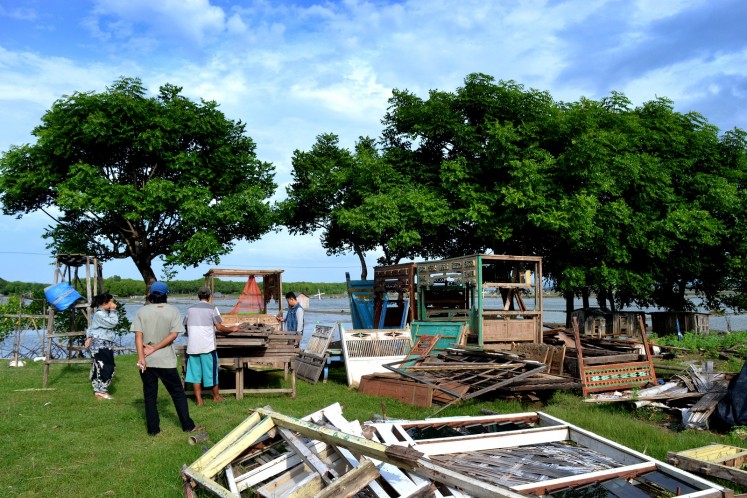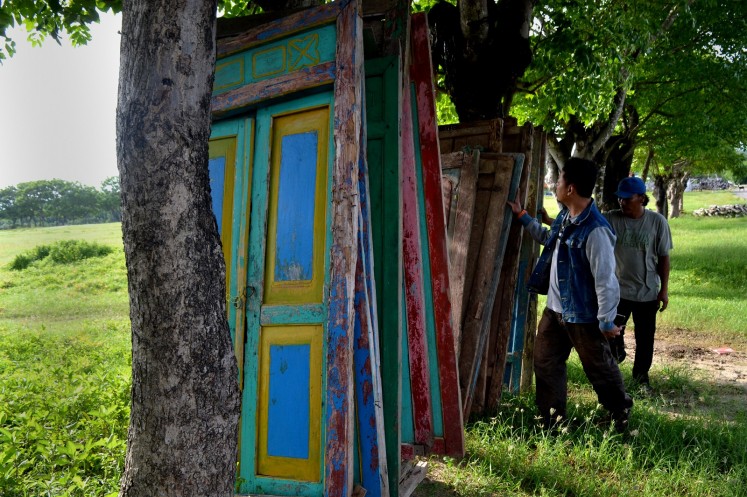Popular Reads
Top Results
Can't find what you're looking for?
View all search resultsPopular Reads
Top Results
Can't find what you're looking for?
View all search resultsBits and pieces of Sumenep’s history on sale
Story from the past of a salt-rich town is narrated through its antiques.
Change text size
Gift Premium Articles
to Anyone
T
he road to the easternmost town of Madura Island is about 170 kilometers from the Suramadu bridge, rolling through the views of villages and beaches. Sumenep, locally known as Songeneb, was established when Arya Wiraraja, a political advisor of the Singhasari kingdom, was exiled to Madura. The town’s livelihood relied on salt and tobacco, making the small kingdom a vibrant hub of trade, recording its golden age during the Dutch colonial era.
Sumenep salt was an important trade commodity for the Dutch, with ports and railways built to transport it. The town of Sumenep has gone through a long history of change and experience under the Hindu kingdom, Islamic kingdom, Dutch colonialism, Japan aggression and the independent Republic of Indonesia. These changes took Sumenep to different phases including the golden age and difficult times.
Read also: Six destinations to check out in Sumenep
The historical traces of Sumenep crossing through the different ages are still visible today. Some landmarks can be seen dotted around the coastal area of Kalianget with colonial style heritage buildings. There is a palace and an old mosque built in oriental style, and the heritage houses of the Madurese are in a mix of Javanese-Dutch-Chinese architecture. That hybrid style is known as lodji.
As time passes, the glorious past of Sumenep as a salt-producing town still attracts people from outside the island. Antiques from the old days of Sumenep are now the target of collectors from Indonesia and foreign countries alike. Decades old furniture such as wardrobes, wooden trunks, sculpted room partitions, tables, chairs and beds are being sold in Sumenep, particularly in the Kalianget area.
Riyanto, an antique dealer with 10 years of experience in Kalianget, said the antiques from Sumenep are in high demand by collectors from Jakarta, Bali and Yogyakarta. The collectors then resell the antiques to foreign buyers. Riyanto sourced the antiques from villages around Sumenep, including Kalianget at the coast to the hillsides of Lenteng and Saronggi. The lodji, far inside the villages, usually keep the authentic wares of Sumenep. Following purchase, dealers will commission carpenters to restore the antiques to prime condition.
Read also: Find antique goods at pekanbarus oldest market pasar bawah
An antique dealer shows old doors of Madurese houses to a potential buyer. (JP/Stefanus Ajie)Apart from antique furniture and home wares; old doors, windows and house pillars also attract collectors. Furniture from the old days in Sumenep are characterized with unique sculpting, a mix of Jepara (a regency in Central Java) style and oriental influence. The typical oriental images of dragons, phoenix and clouds are seen sculpted on Sumenep antique furniture, particularly the old style Lencak (bed). The detail of sculpting, wood quality and age of the antiques determines the price of the goods. Old beds, one of the most sought after items, cost around Rp 35 million (US$2,566), but the older ones in excellent condition could reach hundreds of million of rupiah.
As the time passes in Sumenep, bits and pieces of the city’s heritage are transported out of the island. Old beds now become gazebo or terrace decoration at holiday resorts, cafés or new houses. So are the doors and windows sculpted with images of phoenix in vibrant colors, now attached to new houses somewhere outside Madura. Now narrated nationwide or abroad through antique furniture and house parts, the glorious story from the past of a salt-rich town. (mut/kes)













